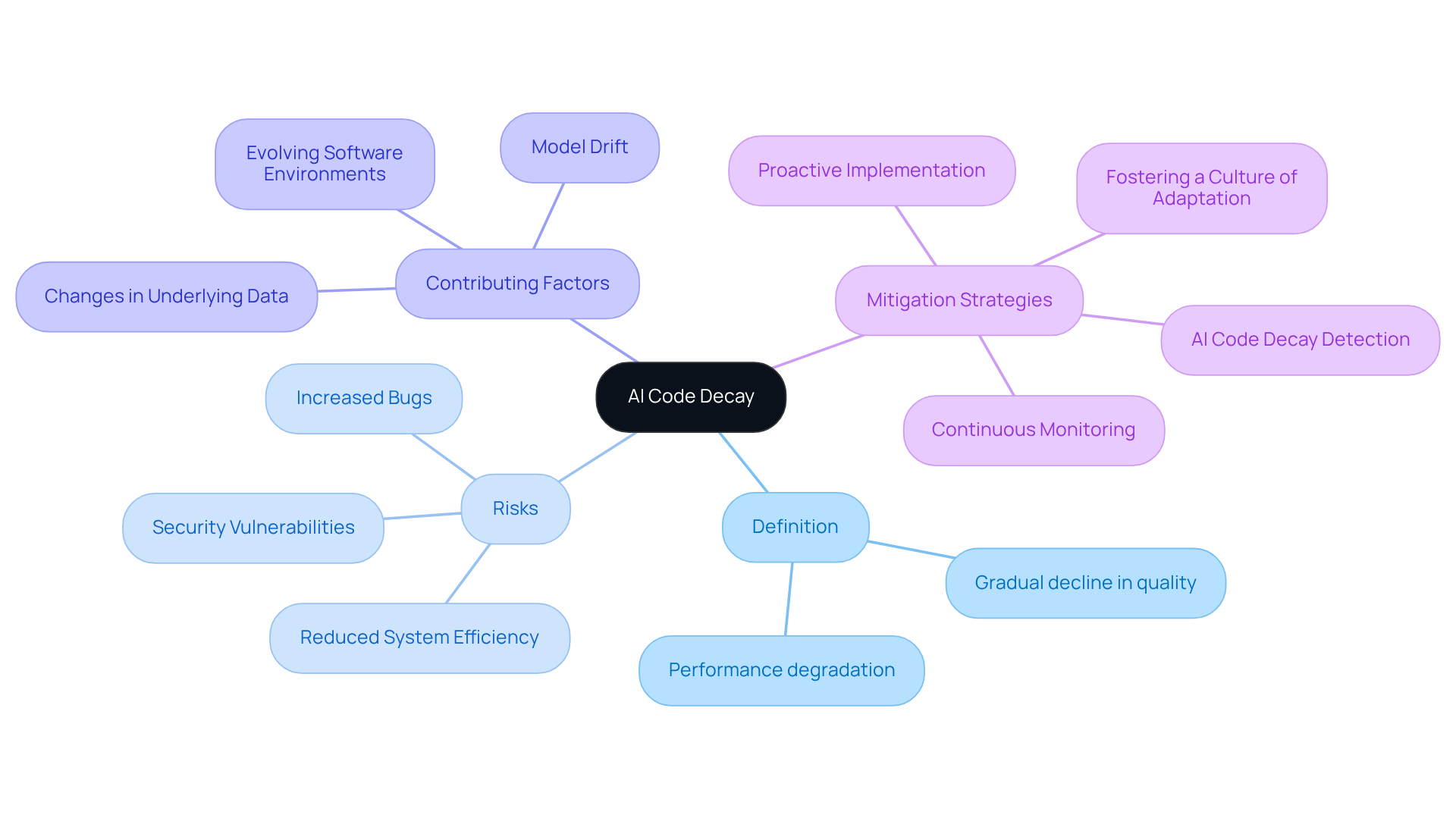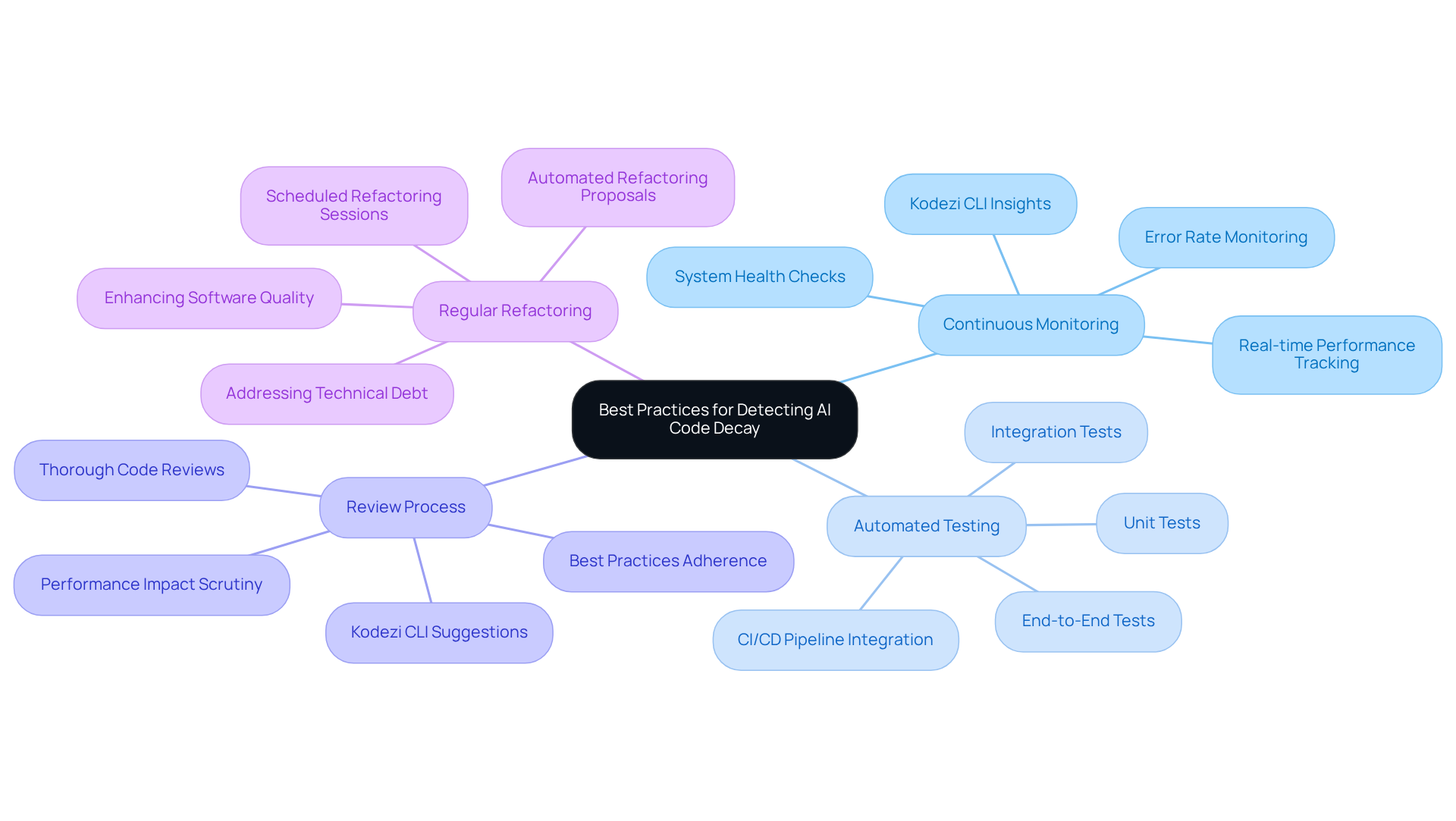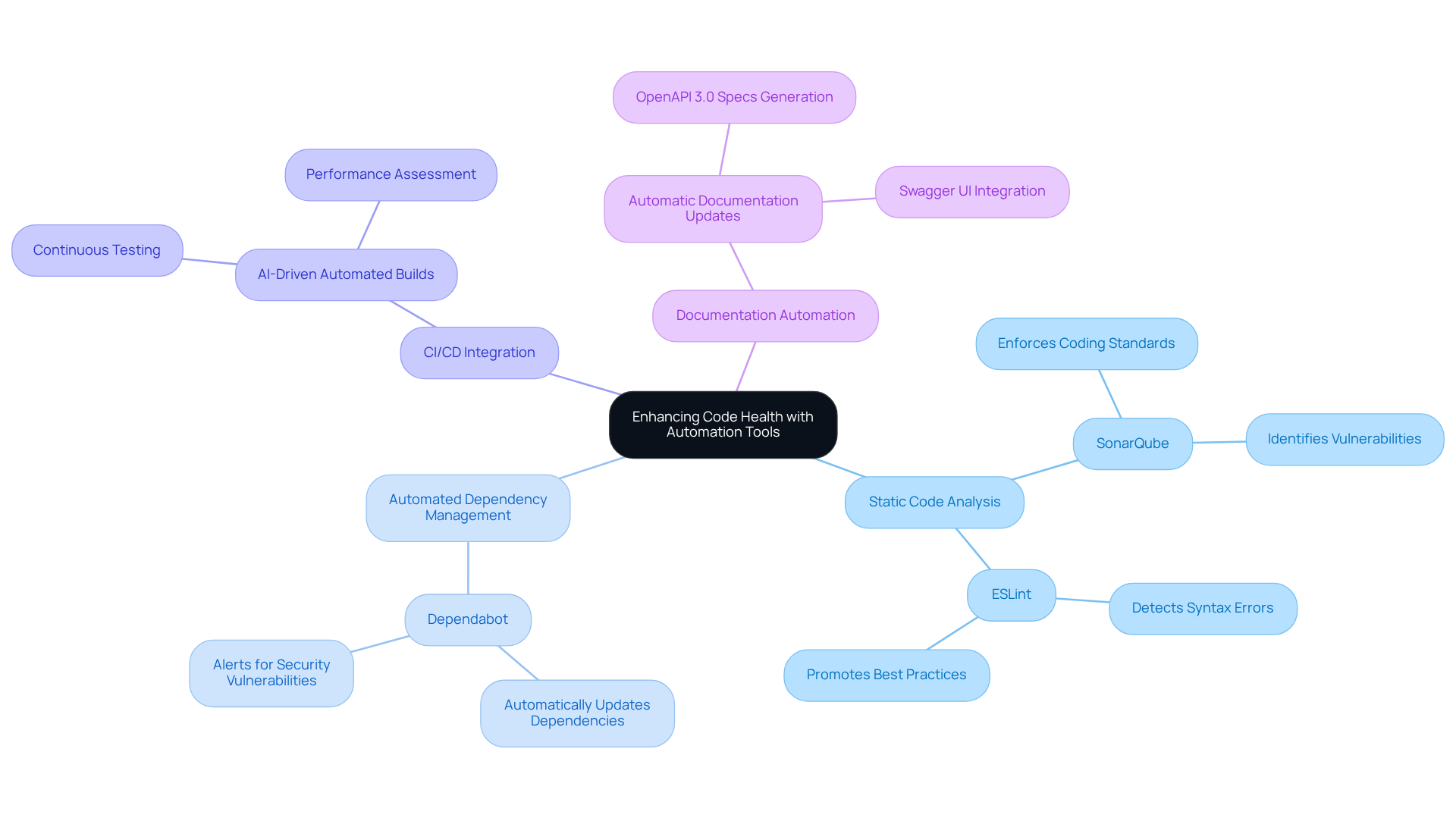Overview
Developers often face significant challenges when it comes to maintaining code quality. With the rapid evolution of technology, issues like AI code decay can hinder productivity and efficiency. So, how can developers effectively tackle these coding challenges?
Enter Kodezi, a platform designed to help developers manage and mitigate these issues. By offering continuous monitoring and automated testing, Kodezi ensures that software quality remains high. Furthermore, it leverages automation tools to streamline processes, making it easier for developers to focus on what truly matters—writing great code.
Imagine having real-time performance tracking and automated documentation updates at your fingertips. These features not only help in identifying problems like model drift and data decay but also empower developers to proactively address them. The result? Improved productivity and enhanced code quality.
Are you ready to elevate your coding practices? Explore the tools available on Kodezi and discover how they can transform your development workflow. With Kodezi, you can tackle code decay head-on and ensure your software remains efficient and reliable.
Introduction
Navigating the challenges of AI code decay is essential for developers in today’s fast-paced software development environment. As applications evolve, the risk of performance degradation becomes a significant concern, impacting both efficiency and security. This article explores effective strategies for detecting and mitigating AI code decay, providing insights that empower teams to sustain robust applications.
How can developers tackle the silent deterioration of their codebases? Kodezi offers a range of features designed to address these challenges head-on. By leveraging its tools, developers can enhance their coding practices, ensuring their software remains resilient amidst constant change.
Imagine a scenario where your application’s performance is consistently optimized. With Kodezi, you can achieve improved productivity and code quality, allowing your team to focus on innovation rather than troubleshooting.
Furthermore, Kodezi’s user-friendly interface makes it accessible for developers at all levels. In addition, its real-time feedback helps identify potential issues before they escalate, saving time and resources.
Are you ready to elevate your coding practices? Explore the tools available on Kodezi and discover how they can transform your approach to software development.
Understand AI Code Decay: Definition and Risks
AI software deterioration presents a significant challenge for developers, as it refers to the gradual decline in quality and performance over time. This decline often stems from changes in underlying data, model drift, or evolving software environments. Have you ever faced increased bugs or reduced system efficiency in your projects? These risks can lead to potential security vulnerabilities, making it crucial to address them.
As software projects evolve, the initial assumptions and circumstances under which the program was created may no longer hold true. This shift can result in unforeseen behaviors and failures that catch teams off guard. Understanding these risks is essential for engineering teams aiming to maintain robust and reliable applications by utilizing AI code decay detection. In dynamic environments, where continuous integration and deployment are the norms, this knowledge becomes even more vital.
Furthermore, by recognizing the signs through AI code decay detection, teams can proactively implement strategies to mitigate these risks. This not only enhances system performance but also safeguards against potential security threats. In addition, fostering a culture of continuous monitoring and adaptation can lead to improved software resilience.
Ultimately, staying informed about AI code decay detection empowers developers to create more effective solutions. By prioritizing these considerations, teams can ensure their applications remain reliable and efficient, even as the landscape of technology continues to change.

Identify Types of AI Code Decay: Model Drift, Data Decay, and More
Coding challenges can be a significant hurdle for developers, impacting productivity and code quality. One of the critical issues is AI code decay, which can manifest in several forms:
- Model Drift: This happens when the statistical properties of the model's input data change over time, leading to decreased accuracy and performance. Regularly retraining models with updated data is essential for AI code decay detection to mitigate this risk.
- Data Decay: As data ages, its relevance may diminish, resulting in outdated insights and predictions. Continuous data validation and cleansing processes are necessary to maintain data integrity.
- Dependency Decay: Changes in external libraries or frameworks can introduce incompatibilities or vulnerabilities. Keeping dependencies updated and monitoring for breaking changes is crucial.
- Documentation Decay: As software develops, documentation may become outdated, leading to confusion and inefficiencies. Consistently refreshing documentation guarantees that all members have access to precise information.
Furthermore, Kodezi addresses these challenges effectively. By providing tools that ensure regular updates and validations, Kodezi helps maintain the integrity of your code and data. Imagine the benefits of improved productivity and enhanced code quality when you leverage such features.
In addition, Kodezi's platform encourages developers to reflect on their coding practices. Have you ever considered how outdated dependencies might affect your projects? With Kodezi, you can stay ahead of potential issues, ensuring your code remains robust and reliable.
Similarly, the emphasis on clear documentation means that your team can work more efficiently, reducing confusion and streamlining processes. Explore the tools available on Kodezi's platform and experience the difference for yourself.

Implement Best Practices for Detecting AI Code Decay: Monitoring and Maintenance Strategies
Coding challenges can often feel overwhelming for developers. How do you ensure your code remains efficient and is monitored for ai code decay detection? This is where Kodezi comes in, offering a suite of features designed to tackle these issues head-on.
-
Continuous Monitoring is essential. By implementing monitoring tools that track performance metrics, error rates, and system health in real-time, you can stay ahead of potential problems. Kodezi CLI autonomously improves your codebase by providing real-time insights and alerts, allowing teams to identify issues before they escalate.
-
Automated Testing is another critical aspect. Regularly executing automated tests helps catch regressions and ensures that new modifications don’t introduce bugs. By incorporating unit tests, integration tests, and end-to-end tests into your CI/CD pipeline, you can leverage Kodezi CLI to enhance testing efficiency with its automated test generation and execution features.
-
Have you considered the importance of a Review Process? Establishing a culture of thorough reviews can help in ai code decay detection by catching potential decay early. Encourage team members to scrutinize changes for adherence to best practices and potential impacts on performance. Kodezi CLI supports this by highlighting areas needing attention and suggesting improvements.
-
Lastly, don’t overlook the value of Regular Refactoring. Scheduling periodic refactoring sessions helps address technical debt and enhances software quality. Kodezi CLI aids in maintaining a tidy and effective codebase by utilizing ai code decay detection to automatically identify issues and propose refactoring opportunities, thereby decreasing the chance of deterioration.
By utilizing Kodezi, you not only improve productivity but also enhance the overall quality of your code. Why not explore the tools available on the platform today?

Leverage Automation Tools: Enhancing Detection and Maintenance of Code Health
Coding challenges can be daunting for developers, often leading to missed deadlines and compromised software quality. Fortunately, employing automation tools can significantly enhance your team's ability to identify and uphold software quality. Kodezi offers a range of solutions designed to tackle these issues head-on.
-
Static Code Analysis is one such feature. Tools like SonarQube or ESLint automatically analyze your code for potential issues, enforcing coding standards and pinpointing vulnerabilities before they reach production. This proactive approach not only saves time but also ensures a higher quality output.
-
In addition, Automated Dependency Management with tools like Dependabot keeps your project secure. It automatically updates dependencies and alerts your team to potential security vulnerabilities in third-party libraries. This means you can focus on coding while staying protected against risks.
-
Furthermore, integrating CI/CD with Kodezi’s AI-driven automated builds and testing tools ensures that every modification is assessed for performance and quality prior to deployment. Automated testers catch issues before they proliferate, enhancing your software quality with each release. Isn’t it reassuring to know that your code is being tested continuously?
-
Documentation Automation is another game-changer. By leveraging tools that automatically update documentation based on code changes, you ensure that your documentation remains current and useful for all team members. Kodezi’s automatic generation of OpenAPI 3.0 specs and Swagger UI streamlines API documentation and testing, further enhancing your development process.
By adopting these tools, you not only improve productivity but also elevate the quality of your code. Ready to explore how Kodezi can transform your coding practices? Dive into the tools available on the platform and see the difference for yourself!

Conclusion
Staying ahead of AI code decay is crucial for developers who want to maintain high-quality, efficient software. Have you ever faced challenges in keeping your codebase healthy? This article has explored the critical concept of AI code decay, emphasizing its definition, associated risks, and types such as model drift, data decay, and dependency decay. By understanding these elements, teams can better prepare for the challenges that arise as their software evolves.
Key strategies for detecting and mitigating AI code decay have been discussed, including:
- Continuous monitoring
- Automated testing
- Thorough review processes
- Regular refactoring
Furthermore, leveraging automation tools like static code analysis and automated dependency management can significantly enhance code health and productivity. Kodezi's suite of features provides the necessary support for developers to implement these best practices effectively.
Ultimately, embracing these practices not only safeguards the integrity of AI systems but also fosters a culture of continuous improvement within development teams. In addition, by prioritizing AI code decay detection and maintenance, developers can ensure their applications remain robust and reliable. This paves the way for innovation and success in a rapidly changing technological landscape. Taking proactive steps today will lead to a more resilient software future. Why wait? Explore the tools available on Kodezi and elevate your coding practices!
Frequently Asked Questions
What is AI code decay?
AI code decay refers to the gradual decline in quality and performance of AI software over time, often due to changes in underlying data, model drift, or evolving software environments.
What causes AI code decay?
AI code decay can be caused by changes in the data that the software relies on, shifts in the software environment, and the initial assumptions made during the program's creation becoming outdated.
What are the risks associated with AI code decay?
The risks include increased bugs, reduced system efficiency, unforeseen behaviors, failures, and potential security vulnerabilities.
Why is it important for engineering teams to understand AI code decay?
Understanding AI code decay is essential for maintaining robust and reliable applications, especially in dynamic environments with continuous integration and deployment.
How can teams detect AI code decay?
Teams can detect AI code decay through AI code decay detection methods that help recognize the signs of deterioration in software performance.
What strategies can teams implement to mitigate the risks of AI code decay?
Teams can proactively implement strategies such as continuous monitoring, adaptation, and fostering a culture of resilience to enhance system performance and safeguard against security threats.
How does staying informed about AI code decay detection benefit developers?
Staying informed empowers developers to create more effective solutions and ensures that applications remain reliable and efficient as technology evolves.




